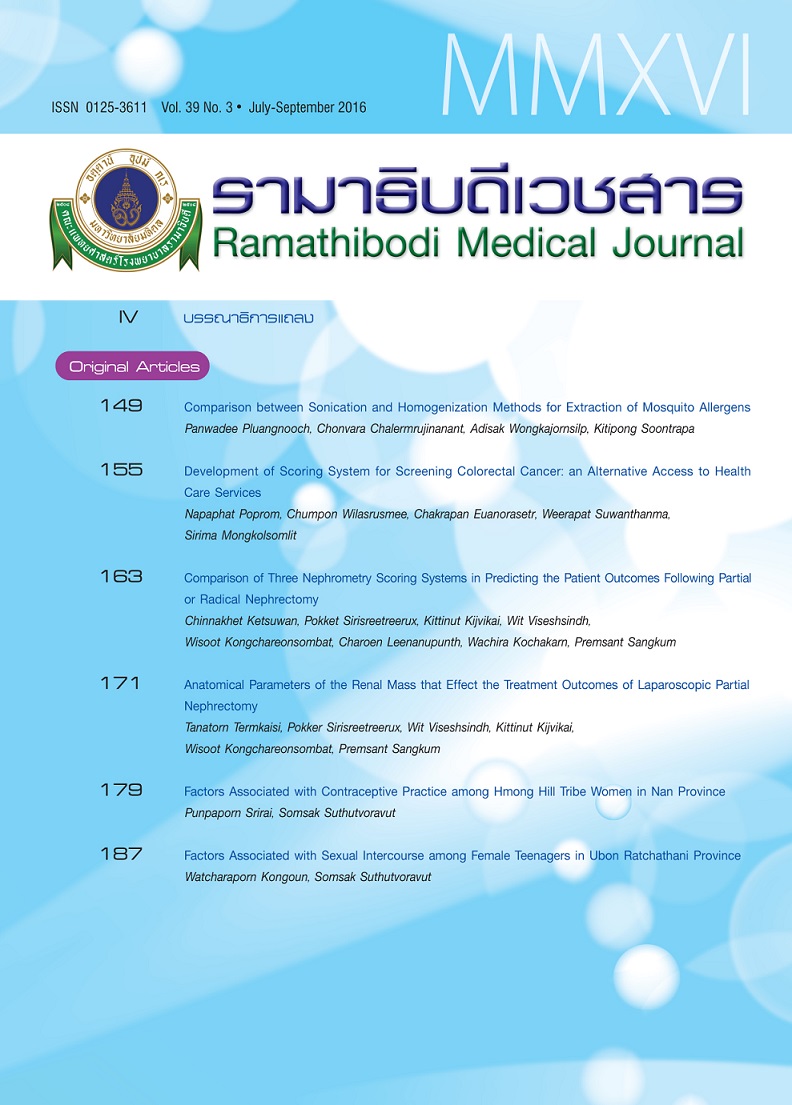Factors Associated with Contraceptive Practice among Hmong Hill Tribe Women in Nan Province
Keywords:
Contraceptive practice, Contraception, Modern method, Traditional methodAbstract
Background: Hill tribe women in Thailand still have high crude birth rate with low rate of contraceptive use. This leads to poor quality of life and poor societal development.
Objective: To study the rate and factors associated with contraceptive practice among Hmong hill tribe women in Nan Province, Thailand.
Methods: This research is a cross sectional survey study. Data was collected by self-administered questionnaire from 284 married Hmong hill tribe women aged 15-44 years old.
Results: We noted 56% of the Hmong hill tribe women of reproductive age used contraceptives; 41.6% used modern methods, while 14.4% used traditional methods. By univariate analysis, the factors significantly associated with contraceptive practice included age, income, easy accessibility to the contraceptive services, cheap contraceptive service, receiving advice from health personnel, satisfaction of contraceptive services, ever attended education class of contraception and ability to advice other people about contraception. When multiple logistic regression analysis was applied, age, easy accessibility to the contraceptive services and satisfaction with contraceptive services were independently associated with contraceptive use.
Conclusions: Rate of contraceptive practice among Hmong hill tribe women of reproductive age in Nan Province was still low and significantly associated with accessibility, understanding and attitude toward contraception and satisfaction with service which enable them to advise others people about contraception. Thus, contraceptive service should be actively improved and developed which included education and promotion of knowledge of contraception to the Hmong Hill tribe women.
References
Freedman R. Theories of fertility decline: A reappraisal. In: Hauser P, editor. World population and development. New York: University Press; 1979.
Population division, Department of economic and Social affairs. United Nation secretariat. Fertility, contraception and population policies. New York: United Nations 2003.
Podhisita C, Kunstadter P, Kunstadter SL. Evidence for early fertility transition among the Hmong in Northern Thailand. J Population Social Studies. 1990;2:137-55.
Kunstadter P. Highland population in northern Thailand. In: Mckennon J, Bruksasri W, editors. Highlanders of Northern Thailand. Kuala Lumpur: Oxford University Press; 1983.
Nan Province Health Office. Demograhic registration data. 2554.
Suwanganit N. Developing practice guideline of birth control among Hmong hill tribe (Dissertaion). Chiang Mai: Chiang Mai University; 2004.
Daniel WW. Biostatics, A foundation for analysis in the health science. Singapore: John Wiley & Son; 1995.
Mangal SK, Mangal S. Research Methodology in Behavioral Sciences. Bangkok: PHI Learning Private Limited; 2013. p. 292-3.
Luu DD. Contraceptive use pattern in central coast of Vietnam. Population and reproductive health research (Dissertaion). Nakornprathom: Mahidol University; 1995.
Banouvong V. Contraceptive used among rural married women in Xiengngun Distrct, Luangprabang Province, Lao PDR (Dissertaion). Nakornprathom: Mahidol University; 1999.
Win KS. Contraceptive use among Myanmar Migrant women in Samut Sakorn Province, Thailand (Dissertaion). Nakornprathom: Mahidol University; 2002.
Sithong U, Somrongthong R. Assessment of use of family planning services among minority women of reproductive age in Thong Pha Phume minority settlement, Karnchanaburi province, Thailand. J Health Res. 2007;31:219-2.
Downloads
Published
How to Cite
Issue
Section
License
Copyright (c) 2016 By the authors. Licensee RMJ, Faculty of Medicine Ramathibodi Hospital, Mahidol University, Bangkok, Thailand

This work is licensed under a Creative Commons Attribution-NonCommercial-NoDerivatives 4.0 International License.













